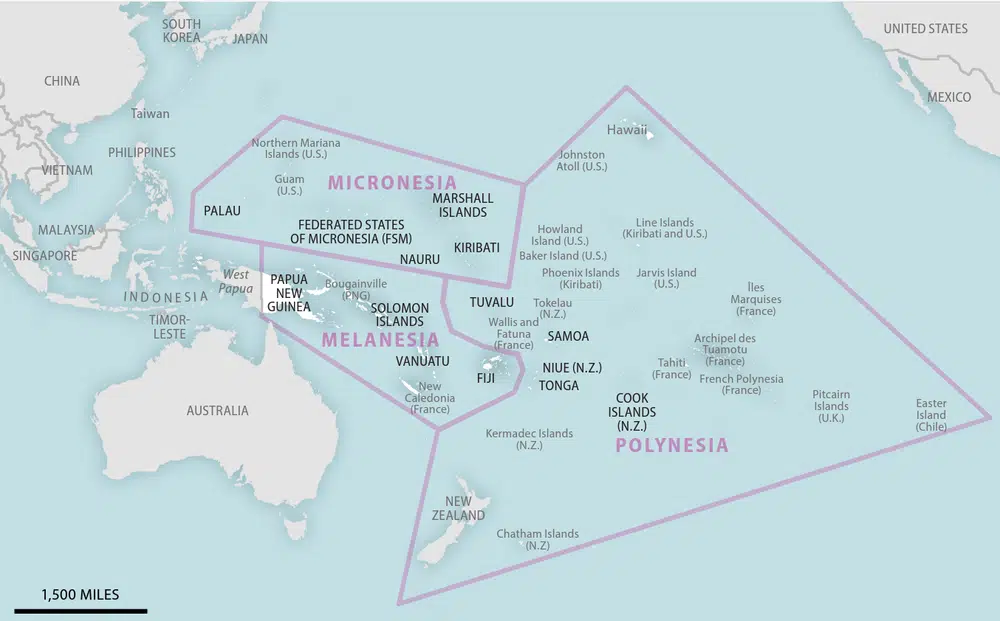There are 1.5 million Americans who identify as Pacific Islander, making up 0.46% of the US population in 2021. Among them, 612,000 reported only Pacific Islander and 929,000 reported Pacific Islander in addition to a different racial group.
Asian Americans are sometimes grouped with Pacific Islanders under the “AAPI” umbrella and are jointly celebrated every May during Asian American and Pacific Islander Heritage Month . The AAPI population is the fastest growing racial group in the US, increasing 27% from 2011 to 2021.
From Hawaiians to Fijians, the Pacific Islander experience in the US is diverse. Educational outcomes and incomes also vary widely between ethnic groups.
What are the different ethnic groups among Pacific Islanders?
The Pacific Islands are divided into three regions: Polynesia, Micronesia, and Melanesia. Ethnicities are based on the island that a person’s family and ancestors originated from.

Map of Pacific Islands
In the US, Native Hawaiians are the largest Pacific Islander ethnic group, followed by Samoans and Chamorros (descendants of the indigenous people of Guam.)
Which states have the highest Pacific Islander populations?
The Pacific Islander population is highly concentrated in a few US states. Over half live in Hawaii (381,000), California (331,000), and Washington (110,000).
Meanwhile, 25 states are home to less than 10,000 Pacific Islanders per state.
What are college graduation rates among Pacific Islanders?
Pacific Islanders graduate from college at lower rates than the national average. Among adults ages 25 and up, one in four (25%) Pacific Islanders have a bachelor’s degree, compared to the nationwide rate of 35%.
Graduation rates also vary across ethnic groups. Chamorro-Americans are most likely to receive a college degree, with 32% having received bachelor’s degree, although this is still below the national average.
What are Pacific Islanders’ income levels and poverty rates?
The economic outcomes of Pacific Islanders are complex.
For those in the US identifying solely as Pacific Islander, the median household income is $69,973, similar to the US median of $69,717. However, poverty rates are higher than the national average. In 2021, 17.6% of Pacific Islanders lived in poverty, compared with 12.8% of the US population.
On average, mixed-race Pacific Islanders also experience better economic outcomes. The median household income is slightly higher at $72,131, and the 14.5% poverty rate is lower than those only identifying as Pacific Islander.
Among Pacific Islanders, Samoan Americans face the highest poverty rates at 17.6%, while Chamorro Americans have the lowest poverty rates and highest median household income.
Pacific Islanders also face higher housing costs than other groups due to the states they live in. On average, Pacific Islander renters pay nearly $300 more in rent than the average American. As a result, homelessness rates among Pacific Islanders are seven times higher than the US average.
How does the government define “Pacific Islander,” and where does the data come from?
In 1997, the Office of Management and Budget outlined the current standards for federal data on race and ethnicity, which separated the “Asian or Pacific Islander” category into “Asian” and “Native Hawaiian or Other Pacific Islander.”
The Census Bureau, following these standards, defines a Pacific Islander as “a person having origins in any of the original peoples of Hawaii, Guam, Samoa, or other Pacific Islands.”
The agency has never had a checkbox for “Pacific Islander” in its official census forms. In 2020 , the agency offered a checkbox for three Pacific Islander ethnic groups — Native Hawaiian, Samoan, Chamorro — along with a fourth “Other Pacific Islander” category accompanied by a fill-in text area.
The latest available demographic data on Pacific Islanders comes from the 2021 American Community Survey. Its economic and educational outcome breakdowns only analyze the largest Pacific Islander ethnic groups in the US.
Learn more about US demographics, Asian American demographics, jobs with the highest representation of Asian Americans, and get the facts every week by signing up for our newsletter.







